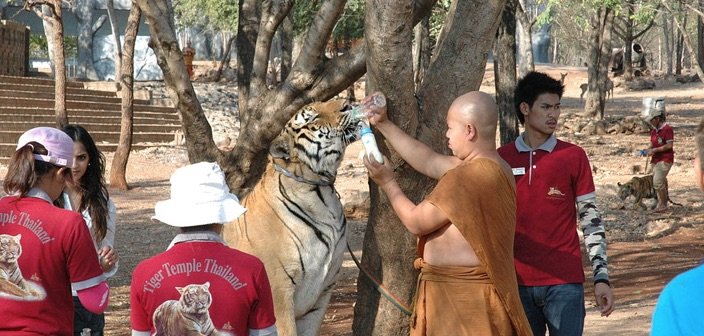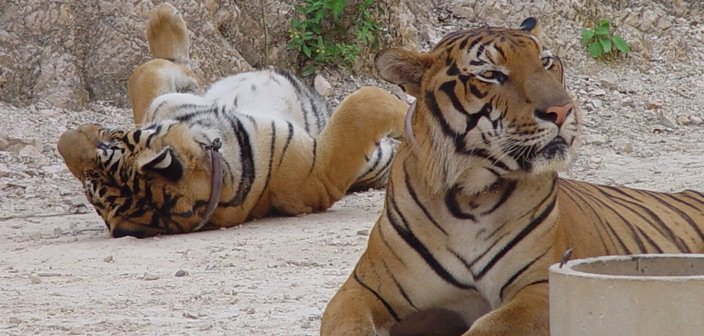Taking Selfies With Tigers
It’s easy to evoke the image of the elusive tiger in a tropical rainforest or Indian grassland, but it’s quite a different undertaking to conceive a tiger posing for a Facebook selfie. For well over 100 tigers in Kanchanaburi Province, Thailand that was precisely their reality – drugged and tied to chains, within the confines of a concrete temple, surrounded by monks and smartphone-clad tourists.
Thailand’s ‘Tiger Temple,’ as it became known, crafted its image as a sanctuary for tigers. A place where consecrated monks took in helpless and abandoned cubs that grew into formidable, yet ‘tamed’, beasts for visitors to enjoy. For decades, it was a famous tourist destination spot further popularized and legitimized by the documentary, The Tiger and the Monk, distributed on platforms such as Netflix and Amazon. The film portrays a false, romantic image of the pious man and majestic beast in harmony and friendship. Unwittingly, these platforms continue to be part of the propaganda spreading the misleading image of a charitable Tiger Temple and others like it.
The Tiger Temple drew in 100 to 300 visitors per day whom eagerly paid to be able to touch the impressive animals and take selfies with the tigers. So-called sanctuaries, like the Tiger Temple, sedate tigers and chain them down, all so that they can be docile enough to be touched and in close proximity to humans. But tigers can easily kill humans and the methods of the tiger temple to create a safe place for us to get close to tigers began to raise questions about animal cruelty. Since 2001, conservation and activist groups have expressed concern with the operations of the Tiger Temple and many others like it. They questioned, what are these sanctuaries doing to help tigers? How and where are they attaining their tigers? And what happens to the tigers rotated out of the grounds? Conservation and Environmental Education for Life, or Cee4Life, an Australian nonprofit carried out a several year investigation and found that the Temple was involved in extensive animal abuse and “has been proven guilty of multiple animal abuse acts.”. As detailed in their report:
Even though the Tiger Temple has sufficient funding to supply all the tigers with an appropriate living environment, 150+ tigers are forced to share approximately 20 outdoor enclosures. The cages they spend 90% of their lives inside are wet, dirty and without enrichment. This does not allow the tigers to live free from discomfort by providing an appropriate environment.
The report further asserts that “the Tiger Temple is conducting illegal international wildlife trade and has ever since its inception,” using the sanctuary as a means for clandestine trade in tigers and tiger parts, violating national laws and international agreements. After their investigation, a coalition of 39 conservation organisations, including WWF and Humane Society International, joined together to advocate the closure of the Tiger Temple.
In late May 2016, the Thai government shut down the Tiger Temple, seized the tigers and raided the facilities. The government investigation is still ongoing, but among what they have found thus far are 40 frozen bodies of tiger cubs with the intention for the criminal sale of their parts.
The silver lining in this horrific situation is that it sheds light on the larger issue that there is a worldwide epidemic of wildlife crime and abuse. Many more fraudulent sanctuaries like the Tiger Temple exist and need to be locked down. These are sites of tiger farming, bear bile farming, illicit wildlife trade, and wildlife abuse – in China alone there are 5,000 illegal tiger farms. Today we are at an all-time high of illegal wildlife trade and crime. Only with global awareness and condemnation, governments will have to take action and abide by international agreements.
Informed and responsible travel is a critical element to not fuel sites like the Tiger Temple. As a community of conscious, globetrotting individuals, we can have a positive impact on wildlife populations by realising the power of our purchasing decisions. Such actions include avoiding certain souvenirs such as tortoise shell or coral, patronising sanctuaries and zoos that are certified and supported by reputable organisations, and even by reporting instances of wildlife violations during your travels.
Though the atrocities of the Tiger Temple are shocking, it is hopeful that it can help serve as a critical turning point for the global community and together we can forge a future positive relationship with nature and wildlife.
If you are heading off on an adventure and want to avoid contributing to animal cruelty here are some further resources on responsible travel:
- List of souvenirs to avoid by country
- WWF pamphlet on wildlife souvenirs to avoid:
- Basics on responsible wildlife tourism:
- Wildlife reporting app while traveling in Southeast Asian countries:
Main Image Source: Sumatran Tiger from WorldWildlifeFund


